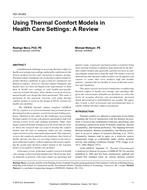
HO-18-003 — Using Thermal Comfort Models in Health Care Settings: A Review
- Comments Off on HO-18-003 — Using Thermal Comfort Models in Health Care Settings: A Review
- ASHRAE
Click here to purchase
A fundamental challenge in assessing thermal comfort in healthcare settings is providing comfortable conditions for the diverse medical services and concurrent occupancy groups. Thermal comfort standards rely on thermal comfort models to predict thermal conditions in spaces that are satisfactory for human occupancy. However, thermal comfort standards and models have not been developed from experimental or field data in health care settings or withhealth care specific concerns in mind; therefore, their validity to assist in environmental health care design has been questioned. This study is motivated by the practical concerns with using thermal comfort models to assist in the design of HVAC systems for health care facilities.The ASHRAE thermal comfort standard (ASHRAE 2017a) requires a set of environmental and personal factors that depend on the occupants; activity levels and clothing insulation. Outlined in this study are the challenges in providing thermal comfort in rooms with patients and medical staff with varying activity levels and clothing insulation. Other challenges explored include looking at activity levels that are near or above the research that was used to develop the comfort models and the lack of insulation values for the clothing required to be worn by some medical personnel. This study also reviews the complexity and diversity of patients, their levels of health, and the care they are receiving relative to the assessment of thermal comfort. A final complexity discussed is applying the steady state thermal comfort models to the transient nature of occupants in health care facilities.A literature review of thermal comfort research in health care settings is discussed and summarized. The focus has been on hospitals in general, with some studies on operating and patient rooms. A general conclusion points to patients being more tolerant of indoor conditions than predicted by the thermal comfort models and, generally, patients are more accepting of higher temperatures than the staff. The studies reviewed demonstrate that thermal comfort models can be applied with caution to rooms that serve medical staff and healthy patients;patients that are healthy in terms of thermal sensation and regulation.This paper exposes increased complexities in addressing thermal comfort in health care settings and concludes that given the critical nature of health care facilities, as well as the levels of occupant diversity and specialization, increased detail and attention to individualities are needed. The paper also reveals a lack of personal and environmental data to enable reliable thermal comfort assessments.
Citation: 2018 Annual Conference, Houston, TX, Technical Papers
Product Details
- Published:
- 2018
- Number of Pages:
- 12
- Units of Measure:
- Dual
- File Size:
- 1 file , 1 MB
- Product Code(s):
- D-HO-18-003

